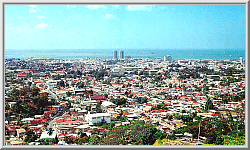
| MORE ABOUT TOBAGO |
| PORT OF SPAIN |
 Trinidad's capital city is a study in contradictions. The old jostles with the new, the beautiful with the distasteful, wealth rubs shoulders with poverty. Descendants of slaves live side by side with descendants of their colonial masters. Urban to the core, the heart of Port Of Spain is nevertheless a huge grassland known as the Savannah.
Trinidad's capital city is a study in contradictions. The old jostles with the new, the beautiful with the distasteful, wealth rubs shoulders with poverty. Descendants of slaves live side by side with descendants of their colonial masters. Urban to the core, the heart of Port Of Spain is nevertheless a huge grassland known as the Savannah.
Port Of Spain spreads eastward from the Gulf of Paria, expanding into the foothills and valleys of the Northern Range. Incorporated as a city on June 26, 1914, it had started out three hundred years ago as no more than a small fishing village of thatched huts, known as Puerto de Los Hispanoles (Port of the Spaniards).
In 1757, the newly arrived Spanish Governor decided to make this coastal settlement his place of residence, since his quarters in the official capital San Jose de Oruna (now St. Joseph) was in a state of advanced despair. This caused a dispute between the governor and the council he was supposed to govern; the issue was not resolved until 1784, when Port Of Spain was officially declared the capital.
The British invaded Trinidad in 1797; shortly afterward, in 1803, the first reclamation of lands on the muddy foreshore began, creating the areas known as South Quay and Independence Square. Further effort circa 1845 and 1906 extended the reclaim lands westward along the foreshore. The city core as it exists today was laid out by Sir Ralph Woodford, who arrived in Trinidad in 1813 to take up his post as Governor. A devastating fire in 1808 had razed the downtown to the ground; Woodford had virtually a clean slate on which to leave his mark. He is responsible for many of the city's most notable landmarks, including the Queen's Park Savannah, the Botanic Gardens, the Anglican and Catholic Cathedrals, and the shady square in the centre of the city which he christened Brunswick Square, but which today bears his name. Port Of Spain offers visitors a wealth of experiences: from the overcrowded, but nevertheless vibrant street markets of downtown to the air-conditioned orderliness of the suburban malls; from the old colonial splendour of the mansions around the Savannah to the ultra-modern steel and glass of the Financial Complex; from the "doubles" vendors of Independence Square to the fine restaurants boasting "continental" cuisine; from the corner rum shops to the trendy discos- there's never a lack of things to see and do.
As the centre of the countries commercial, political and social life, Port Of Spain is the home of numerous embassies and international commissions. Its harbour welcomes cargo and passenger ships from around the world. The city serves the hub to a number of satellite residential communities, and boasts an impressive list of interesting tourist attractions.
| Port Of Spain City Corporation |
FINANCIAL COMPLEX

Dominating the skyline of Port Of Spain, the twin towers of the Financial Complex are the tallest buildings of the English-speaking Caribbean. Clad in solar-insulated glass supposedly strong enough to withstand earthquakes, the towers rise to 22 stories, or 92m (302ft) above the ground level. Construction on the Complex began in 1979; the building was opened in March 1986. The excavation site revealed a wealth of historical artifacts, including ships' anchors, cannon balls, Amerindian pottery, and the old sea walls of the city.
The Financial Complex offices some of the most important offices in the country: the Prime Ministers office, the office of the Governor of the Central Bank, all Central Bank operations and a number of departments of the Ministry of Finance. It is also known as the Eric Williams Plaza, in honour of the nations first Prime Minister. The complex appears on the newer Trinidad and Tobago currency notes.
The interior of the Complex is decorated with the works of local artists and sculptors; temporary exhibitions frequently grace the halls of the main lobby. Culture is also catered in the Central Bank Auditorium, a favourite performance space for theater, concerts and other artistic activities.
 |
Copyright © 2003-2008. All rights reserved.
 |
